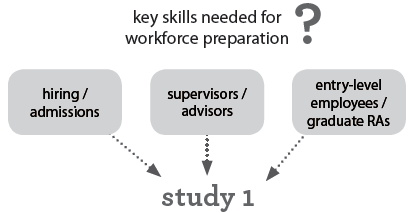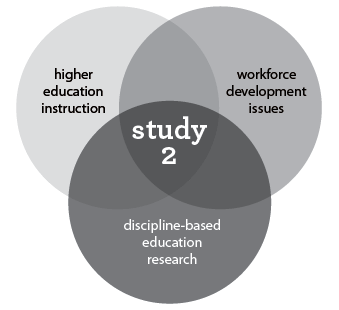Photonics and Optics Workforce Education Research (POWER)
- RIT/
- Center for Advancing Scholarship to Transform Learning/
- Research/
- Research Groups/
- Photonics and Optics Workforce Education Research
Photonics and Optics Workforce Education Research (POWER) unites higher education, discipline-based education research, and workforce development in order to investigate core aspects of typical undergraduate STEM programs: scientific content, mathematics, and communication.
This project is funded through a National Science Foundation Education and Human Resources Core Research (ECR) grant DGE-1432578.
In the Photonics Careers Project, we are studying the early careers of technicians, engineers, and researchers to better understand the transition from school to jobs. With perspectives drawn from employees and managers, PhD students and their supervisors, we are learning about key math, physics, technical and communication skills that are essential for success. We are doing foundational research that supports stronger bridges between school and work and between the industry advocates for workforce development and the academic communities focused on education research. The Photonics Careers Project will provide additional research-based clarity that informs national discussion and policy around STEM workforce preparation.
Why Do Education Research on the Optics and Photonics Workforce in Rochester?
With the physical sciences, photonics is rich in basic research and technological applications in health and medicine, advanced manufacturing, defense and national security, energy, communications, and advanced manufacturing.
Rochester is home to over 30 companies and leading higher-education institutions. Rochester was the birthplace of the Optical Society of America, and remains a national hub in photonics. RIT is a leader in imaging science, remote sensing, and micro-optoelectronics, and solar energy. The University of Rochester’s Institute of Optics is the largest optics degree granting program in the Country. And Monroe Community College’s Optical Technology program is highly valued by the Rochester industry.
Is There a Local Skills Gap?
- The rhetoric of “skills gaps” abounds in popular discussions about the relationship between higher education and the workforce. Our initial goal is to identify key skills needed for success in the workplace, providing feedback to local higher-ed, students seeking employment, and providing us a better understanding of upward mobility within the local photonics sector.
- We are going beyond many studies by including:
- Multiple perspectives: employers and employees
- Graduate school and industry
- A range of levels of positions (Associates to PhD)

Uniting Higher Education, Discipline-based Education Research, and Workforce Development

Adapting research on improving students’ learning in order to study what makes creative, successful, and satisfied STEM workers.
Focus on core aspect of typical undergraduate STEM programs: scientific content, mathematics, and communication.
Too many discussions of skills in the STEM workplace treat skills such as “advanced math” as a single broad concept. But education research reveals there is no generic skill such as “advanced math,” but rather there are an array of cognitive processes and contextual elements that go into using advanced math to solve scientific problems. This research will more accurately reveal how STEM skills are used in a day-to-day workplace setting, providing necessary information for education researchers wanting to connect their research more closely to the workplace.
Community
Optics and Photonics are part of the past, present, and future of Rochester, NY. The earliest years of Rochester photonics begin with the founding of Bausch and Lomb in Rochester in 1853. During the next hundred years, Bausch and Lomb, Kodak, and Xerox rose to international prominence and established Rochester as the optics hub of the US. Currently, Rochester is home to over 60 small, medium, and large companies in photonics. Several higher education institutions have strong programs aligned with photonics careers, including the Monroe Community College Optical Technology program, RIT Center for Imaging Science, and University of Rochester Institute of Optics. As education researchers, we are thankful for the strong community spirit that has welcomed our education research team, and is helping us better understand the complex transition from school to work. It is our hope and desire that this project would strengthen and benefit the local Rochester community, in addition to informing national discussions of STEM workforce development.
To learn more about Rochester Photonics, visit the New York Photonics.
To network and get involved in optics education outreach, join the Optical Society Rochester Section. Rochester is the birthplace of the Optical Society!
Publications
Project updates (published by POWER)
- One-page document: Rochester Photonics Workforce Development (NSF DGE-1432578) and National 21st Century Skills in STEM Jobs (NSF DGE-1561493)
Peer-reviewed publications
- Zwickl, B. M., Olivera, J., Martin, K. N. and Winans, K., (2015). Preparing students for physics-intensive careers in optics and photonics. Proceedings of the 2015 Physics Education Research Conference, College Park, MD.
Related publications by project leaders
- Martin, K. N., & Gaffney, A. L. H. (2016). Telling and showing: The intersection of visual communication content knowledge and pedagogical strategies in STEM. Visual Communication Quarterly.
- Martin, K. N. (2013). A Mixed Methods Approach for Analyzing the Imagery of a Novel Science. Visual Methodologies, 2(1).
- Martin, K. N. & Murdoch-Kitt, K. M. (2013). A Visual World Demands Design Sense: Advocating for Visual Communication Across the Curriculum. The International Journal of Design Education.

